HST (original) (raw)

Home - Search - Browse - Alphabetic Index: 0- 1- 2- 3- 4- 5- 6- 7- 8- 9
A- B- C- D- E- F- G- H- I- J- K- L- M- N- O- P- Q- R- S- T- U- V- W- X- Y- Z
HST
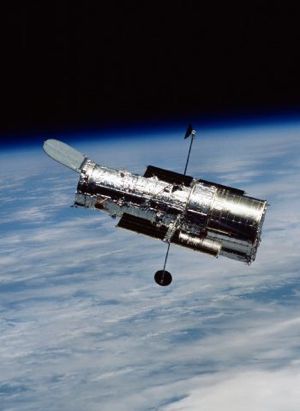
Hubble
Hubble during STS-109
Credit: NASA
American visible astronomy satellite. The Hubble Space Telescope was designed to provide a space telescope with an order of magnitude better resolution than ground-based instruments. Astronomy satellite built by Lockheed for NASA, ESA, Europe. Launched 1990.
AKA: Hubble Space Telescope. Status: Operational 1990. First Launch: 1990-04-24. Last Launch: 1990-04-24. Number: 1 . Gross mass: 10,863 kg (23,948 lb). Height: 13.30 m (43.60 ft).
The initially flawed satellite was repaired, maintained, and upgraded in a series of space shuttle missions extending over a decade.
The Hubble Space Telescope was the visible/ultraviolet/near-infrared element of the Great Observatories astronomical program. The spacecraft provided an order of magnitude better resolution than was possible with ground-based telescopes. The objectives of the HST were to:
- investigate the composition, physical characteristics, and dynamics of celestial bodies
- examine the formation, structure, and evolution of stars and galaxies
- study the history and evolution of the universe
- provide a long-term space-based research facility for optical astronomy. During initial on-orbit checkout of the Hubble's systems, a flaw in the telescope's main reflective mirror was found that prevented perfect focus of the incoming light. This flaw was caused by the incorrect adjustment of a testing device used in building the mirror. Fortunately, however, Hubble was designed for regular on-orbit maintenance by Shuttle missions. The first servicing mission, STS-61 in December 1993, corrected the problem by installing a corrective optics package and upgraded instruments (as well as replacing other satellite components). Further servicing missions were undertaken in 1997, 1999, and 2002. Hubble's successor, the Webb Next Generation Telescope, was authorized in 2002. However so valuable was Hubble, that NASA in 2007 decided to proceed to break its rule after the Columbia disaster of not flying solo shuttle missions and planned a final Hubble servicing mission in 2009.
The program included significant participation by ESA, which provided one of the science instruments, the solar arrays, and some operational support to the program. Responsibility for conducting and coordinating the science operations of the Hubble Space Telescope rested with the Space Telescope Science Institute (STScI) at Johns Hopkins University, who operated it for NASA as a general observer facility available to astronomers from all countries.
Hubble had a 3-axis stabilized, zero momentum biased control system using reaction wheels with a pointing accuracy of 0.007 arc-sec. Two double-roll-out solar arrays (2.3 m x 12 m) generated 5000 W and fed six 60 Ahr batteries. A hydrazine propulsion system allowed coarse attitude control and orbital correction. The S-band communications system used deployed articulated high gain antennas and provided uplink at 1 kbps and downlink (via TDRSS) at 256-512 kbps.
The telescope was an f/24 Ritchey-Chretien Cassegrainian system with a 2.4 m diameter primary mirror and a 0.3 m Zerodur secondary. The effective focal length was 57.6 m. The Corrective Optics Space Telescope Axial Replacement (COSTAR) package was a corrective optics package designed to optically correct the effects of the primary mirror's aberration on the Faint Object Camera (FOC), Faint Object Spectrograph (FOS), and the Goddard High Resolution Spectrograph (GHRS). COSTAR displaced the High Speed Photometer during the first servicing mission to HST.
Instruments included the Wide Field Planetary Camera (JPL), which consisted of four cameras that were used for general astronomical observations from far-UV to near-IR. The Faint Object Camera (ESA) used cumulative exposures to study faint objects. The Faint Object Spectrograph (FOS) was used to analyze the properties of celestial objects such as chemical composition and abundances, temperature, radial velocity, rotational velocity, and magnetic fields. The FOS was sensitive from 1150 Angstroms (UV) through 8000 Angstroms (near-IR). The Goddard High Resolution Spectrometer (GHRS) separated incoming light into its spectral components so that the composition, temperature, motion, and other chemical and physical properties of objects could be analyzed. The GHRS was sensitive between 1050 and 3200 Angstroms.
NASA NSSDC Master Catalog Description
The Hubble Space Telescope (HST) was the first and flagship mission of NASA's Great Observatories program. Designed to complement the wavelength capabilities of the other spacecraft in the program (CGRO, AXAF, and SIRTF), HST was a 2.4 m, f/24 Ritchey-Chretien telescope capable of performing observations in the visible, near-ultraviolet, and near-infrared (1150 A to 1 mm).
Placed into a low-earth orbit by the space shuttle, HST was designed to be modular so that on subsequent shuttle missions it could be recovered, have faulty or obsolete parts replaced with new and/or improved instruments, and be re-released. HST was roughly cylindrical in shape, 13.1 m end-to-end and 4.3 m in diameter at its widest point.
HST used an elaborate scheme for attitude control to improve the stability of the spacecraft during observations. Maneuvering was performed by four of six gyros, or reaction wheels. Pointing could be maintained in this mode (coarse track) or the Fine Guidance Sensors (FGSs) could be used to lock onto guide stars (fine lock) to reduce the spacecraft drift and increase the pointing accuracy.
Power to the two on-board computers and the scientific instruments was provided by two 2.4 x 12.1 m solar panels. The power generated by the arrays was also used to charge six nickel-hydrogen batteries which provided power to the spacecraft during the roughly 25 minutes per orbit in which HST was within the Earth's shadow.
Communications with the satellite were maintained with the TDRS satellites. Observations taken during the time when neither TDRS was visible from the spacecraft were recorded on tape recorder and dumped during periods of visibility. The spacecraft also supported real-time interactions with the ground system during times of TDRS visibility, enabling observers to make small offsets in the spacecraft pointing to perform their observations. HST was the first scientific spacecraft designed to utilize the full capabilities of TDRSS, communicating over either multiple-access or single-access channels at any of the supported transmission rates.
HST was operated in three distinct phases. During the first phase of the mission (Orbital Verification or OV), responsibility for the spacecraft was given to Marshall Space Center. OV consisted of an extended, eight-month checkout of the spacecraft, including test of the on-board computers, pointing control system, solar arrays, etc. This phase was followed by the Science Verification (SV) phase, lasting nearly another year, during which each of the six science instruments was tested to verify their capabilities and set limits on their safe operations during the remainder of the mission. Responsibility for the spacecraft during SV was given to Goddard Space Flight Center. The last phase of the mission, known as the General Observer (GO) phase, was planned to last from the end of SV through the end of the mission and was the responsibility of the Space Telescope Science Institute. General observations were phased in gradually, however, during the SV phase because the OV and SV portions of the mission were considerably longer than expected prior to deployment.
The mission was troubled soon after launch by the discovery that the primary mirror was spherically aberrated. In addition, problems with the solar panels flexing as the spacecraft passed from the Earth's shadow into sunlight caused problems with the pointing stability. Steps were taken to correct these problems, including replacement of the solar panels, replacement of the Wide Field and Planetary Camera with a second-generation version with built-in corrective optics, and replacement of the High-Speed Photometer with COSTAR (Corrective Optics Space Telescope Axial Replacement) to correct the aberration for the remaining instruments.
More at: HST.
Subtopics
| STS-103 Hubble Space Telescope (HST) servicing mission SM-3A. |
|---|
| STS-109 Hubble Servicing Mission 3B. |
|---|
| STS-125 Fourth and final servicing mission to the Hubble Space Telescope. Only shuttle mission authorized prior to shuttle retirement not to go to the ISS - therefore with no means of space rescue should the heat shield be damaged during ascent to orbit. |
|---|
| STS-128A Hubble Space Telescope Servicing Flight 5. Flight delayed, then cancelled after the Columbia disaster. No crew had been named at the time of the loss of Columbia. Resurrected later after Congressional pressure. |
|---|
| STS-31 Deployed the Hubble Space Telescope. |
|---|
| STS-51 First shuttle night landing in Florida. Deployed and retrieved Orfeus-SPAS. During the EVA conducted tests in support of the Hubble Space Telescope first servicing mission and future EVAs, including Space Station assembly and maintenance. |
|---|
| STS-61 Hubble repair mission. Conducted the most EVAs on a Space Shuttle flight to that date. |
|---|
| STS-61-J Planned shuttle mission for deployment of Hubble space telescope. Cancelled after Challenger disaster. |
|---|
| STS-82 Hubble repair mission; five spacewalks. |
|---|
Family: Astronomy, Medium earth orbit, Visible astronomy satellite. Country: USA. Launch Vehicles: Space Shuttle. Launch Sites: Cape Canaveral, Cape Canaveral LC39B. Agency: NASA, NASA Huntsville, Lockheed. Bibliography: 2, 279, 3767, 3768, 3769, 3770, 3771, 3772, 3773, 3774, 3775, 3776, 3777, 3778, 3779, 3780, 3781, 3782, 3783, 3784, 3785, 3786, 3787, 3788, 3789, 3790, 3791, 3792, 3793, 3794, 3795, 3796, 3797, 3798, 3799, 3800, 3801, 3802, 3803, 3804, 3805, 3806, 6, 66, 4984, 11189.
Photo Gallery
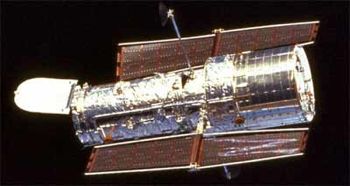 |
HubbleCredit: Manufacturer Image |
|---|
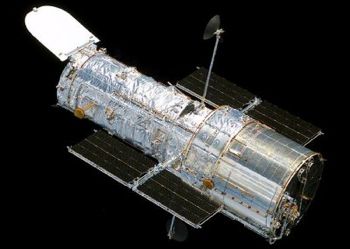 |
HSTCredit: Manufacturer Image |
|---|
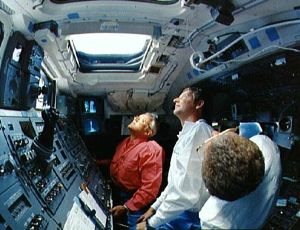 |
STS-31STS-31 crew monitors Hubble Space Telescope (HST) from OV-103's flight deckCredit: NASA |
|---|
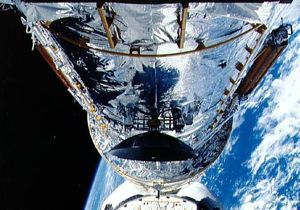 |
STS-31Hubble Space Telescope (HST) above OV-103's PLB during STS-31 deploymentCredit: NASA |
|---|
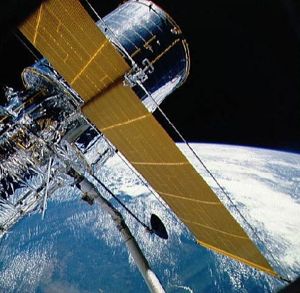 |
STS-31STS-31 Hubble Space Telescope (HST) (SA & HGA deployed) is grappled by RMSCredit: NASA |
|---|
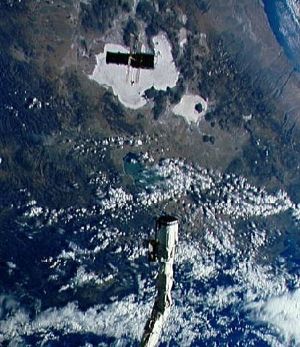 |
STS-31STS-31 Hubble Space Telescope (HST) drifts away from OV-103's RMSCredit: NASA |
|---|
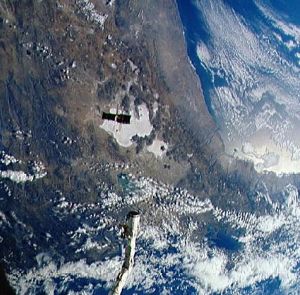 |
STS-31STS-31 Hubble Space Telescope (HST) is released by RMS over Andes MountainsCredit: NASA |
|---|
1986 August - .
- STS-61-J (cancelled) - . Crew: Bolden, Hawley, McCandless, Sullivan, Young. Payload: Hubble. Nation: USA. Related Persons: Bolden, Hawley, McCandless, Sullivan, Young. Program: STS. Flight: STS-61-J. Spacecraft: Atlantis, HST. Planned shuttle mission for deployment of Hubble space telescope. Cancelled after Challenger disaster. .
1990 April 24 - . 12:33 GMT - . Launch Site: Cape Canaveral. Launch Complex: Cape Canaveral LC39B. Launch Platform: MLP2. LV Family: Shuttle. Launch Vehicle: Space Shuttle.
- HST Hubble Space Telescope - . Payload: Hubble Space Telescope. Mass: 10,863 kg (23,948 lb). Nation: USA. Agency: NASA Greenbelt. Class: Astronomy. Type: Astronomy satellite. Spacecraft: HST. USAF Sat Cat: 20580 . COSPAR: 1990-037B. Apogee: 596 km (370 mi). Perigee: 590 km (360 mi). Inclination: 28.50 deg. Period: 96.50 min. Hubble Space Telescope; deployed from STS-31 4/25/90. Spacecraft engaged in research and exploration of the upper atmosphere or outer space (US Cat B)..
1993 June 25 - .
- EVA STS-57-1 - . Crew: Low, Wisoff. EVA Duration: 0.24 days. Nation: USA. Related Persons: Low, Wisoff. Program: STS. Class: Manned. Type: Manned spaceplane. Flight: STS-57. Spacecraft: Endeavour, HST. Latched Eureca antenna. Conducted tests to refine procedures for servicing of the Hubble Space Telescope and construction of the International Space Station.
1993 December 5 - . 03:44 GMT - .
- EVA STS-61-1 - . Crew: Hoffman, Musgrave. EVA Duration: 0.33 days. Nation: USA. Related Persons: Hoffman, Musgrave. Program: STS. Class: Manned. Type: Manned spaceplane. Flight: STS-61. Spacecraft: Endeavour, HST. Hubble Space Telescope Servicing Mission 1 - gyroscope replacement..
1993 December 6 - . 03:29 GMT - .
- EVA STS-61-2 - . Crew: Akers, Thornton. EVA Duration: 0.28 days. Nation: USA. Related Persons: Akers, Thornton. Program: STS. Class: Manned. Type: Manned spaceplane. Flight: STS-61. Spacecraft: Endeavour, HST. Hubble Space Telescope Servicing Mission 1 - solar array replacement..
1993 December 7 - . 03:35 GMT - .
- EVA STS-61-3 - . Crew: Hoffman, Musgrave. EVA Duration: 0.28 days. Nation: USA. Related Persons: Hoffman, Musgrave. Program: STS. Class: Manned. Type: Manned spaceplane. Flight: STS-61. Spacecraft: Endeavour, HST. Hubble Space Telescope Servicing Mission 1 - WFPC-P installation..
1993 December 8 - . 03:13 GMT - .
- EVA STS-61-4 - . Crew: Akers, Thornton. EVA Duration: 0.28 days. Nation: USA. Related Persons: Akers, Thornton. Program: STS. Class: Manned. Type: Manned spaceplane. Flight: STS-61. Spacecraft: Endeavour, HST. Hubble Space Telescope Servicing Mission 1 - COSTAR installation..
1993 December 9 - . 03:30 GMT - .
- EVA STS-61-5 - . Crew: Hoffman, Musgrave. EVA Duration: 0.31 days. Nation: USA. Related Persons: Hoffman, Musgrave. Program: STS. Class: Manned. Type: Manned spaceplane. Flight: STS-61. Spacecraft: Endeavour, HST. Hubble Space Telescope Servicing Mission 1 - solar array drive replacement..
1997 February 14 - . 04:34 GMT - .
- EVA STS-82-1 - . Crew: Lee, Smith, Steven. EVA Duration: 0.28 days. Nation: USA. Related Persons: Lee, Smith, Steven. Program: STS. Class: Manned. Type: Manned spaceplane. Flight: STS-82. Spacecraft: Discovery, HST. Hubble Space Telescope Servicing Mission 2 - NICMOS installation..
1997 February 15 - . 03:25 GMT - .
- EVA STS-82-2 - . Crew: Harbaugh, Tanner. EVA Duration: 0.31 days. Nation: USA. Related Persons: Harbaugh, Tanner. Program: STS. Class: Manned. Type: Manned spaceplane. Flight: STS-82. Spacecraft: Discovery, HST. Hubble Space Telescope Servicing Mission 2 - Guidance sensor replacement..
1997 February 16 - . 02:53 GMT - .
- EVA STS-82-3 - . Crew: Lee, Smith, Steven. EVA Duration: 0.30 days. Nation: USA. Related Persons: Lee, Smith, Steven. Program: STS. Class: Manned. Type: Manned spaceplane. Flight: STS-82. Spacecraft: Discovery, HST. Hubble Space Telescope Servicing Mission 2 - Data interface unit replacement..
1997 February 17 - . 03:45 GMT - .
- EVA STS-82-4 - . Crew: Harbaugh, Tanner. EVA Duration: 0.27 days. Nation: USA. Related Persons: Harbaugh, Tanner. Program: STS. Class: Manned. Type: Manned spaceplane. Flight: STS-82. Spacecraft: Discovery, HST. Hubble Space Telescope Servicing Mission 2 - Solar array drive replacement..
1997 February 18 - . 03:15 GMT - .
- EVA STS-82-5 - . Crew: Lee, Smith, Steven. EVA Duration: 0.22 days. Nation: USA. Related Persons: Lee, Smith, Steven. Program: STS. Class: Manned. Type: Manned spaceplane. Flight: STS-82. Spacecraft: Discovery, HST. Hubble Space Telescope Servicing Mission 2 - Insulation blanket repair..
1999 December 23 - . 18:54 GMT - .
- EVA STS-103-1 - . Crew: Grunsfeld, Smith, Steven. EVA Duration: 0.34 days. Nation: USA. Related Persons: Grunsfeld, Smith, Steven. Program: STS. Class: Manned. Type: Manned spaceplane. Flight: STS-103. Spacecraft: Discovery, HST. Replaced all six of the gyroscopes on Hubble..
1999 December 24 - . 19:06 GMT - .
- EVA STS-103-2 - . Crew: Foale, Nicollier. EVA Duration: 0.34 days. Nation: USA. Related Persons: Foale, Nicollier. Program: STS. Class: Manned. Type: Manned spaceplane. Flight: STS-103. Spacecraft: Discovery, HST. Installed in the Hubble space telescope a new 486/25 mhz computer and replaced Fine Guidance Sensor FGS-2..
1999 December 25 - . 19:17 GMT - .
- EVA STS-103-3 - . Crew: Grunsfeld, Smith, Steven. EVA Duration: 0.33 days. Nation: USA. Related Persons: Grunsfeld, Smith, Steven. Program: STS. Class: Manned. Type: Manned spaceplane. Flight: STS-103. Spacecraft: Discovery, HST. Completed part of the installation of new insulation to the Hubble space telescope. The rest was deferred to the next servicing mission..
2002 March 4 - . 06:37 GMT - .
- EVA STS-109-1 - . Crew: Grunsfeld, Linnehan. EVA Duration: 0.30 days. Nation: USA. Related Persons: Grunsfeld, Linnehan. Program: ISS. Flight: STS-109. Spacecraft: Discovery, HST. The airlock was depressurized at 0630 and repressurized at 1338 UTC. The astronauts replaced the -V2 solar array with the new rigid array stored in the RAC carrier, and replaced a solar array diode box..
2002 March 5 - . 06:40 GMT - .
- EVA STS-109-2 - . Crew: Massimino, Newman. EVA Duration: 0.31 days. Nation: USA. Related Persons: Massimino, Newman. Program: ISS. Flight: STS-109. Spacecraft: Discovery, HST. Depress was at 0634 on and repress was at 1356 UTC. The astronauts replaced the +V2 solar array and diode box, and replaced the RWA-1 reaction wheel assembly..
2002 March 6 - . 08:28 GMT - .
- EVA STS-109-3 - . Crew: Grunsfeld, Linnehan. EVA Duration: 0.29 days. Nation: USA. Related Persons: Grunsfeld, Linnehan. Program: ISS. Flight: STS-109. Spacecraft: Columbia, HST. Depress was at 0825 UTC and repress at 1516 UTC. The HST was powered entirely down and astronauts changed out the power control unit..
2002 March 7 - . 09:00 GMT - .
- EVA STS-109-4 - . Crew: Massimino, Newman. EVA Duration: 0.27 days. Nation: USA. Related Persons: Massimino, Newman. Program: ISS. Flight: STS-109. Spacecraft: Discovery, HST. Depress was at 0856 UTC and repress was at 1630 UTC. The Faint Object Camera was removed and the Advanced Camera for Surveys was installed. The CASH (Cross Aft Shroud Harness) wire harness for the cooling system was installed..
2002 March 8 - . 08:46 GMT - .
- EVA STS-109-5 - . Crew: Grunsfeld, Linnehan. EVA Duration: 0.31 days. Nation: USA. Related Persons: Grunsfeld, Linnehan. Program: ISS. Flight: STS-109. Spacecraft: Discovery, HST.
The EVA ran from 0841 to 1606 UTC. The astronauts installed the NICMOS cooling system (NCS). During preparations for EVA-3, a problem with a valve on Grunsfeld's suit caused it to leak water, and Grunsfeld switched to Newman's suit. For each of EVA-3,4,5 the appropriate size legs and arms were replaced on the same basic HUT (Hard Upper Torso)/PLSS (Primary Life Support System) combination.
2002 March 9 - .
- HST redeployed - . Nation: USA. Spacecraft: Columbia, HST. HST was deployed from Columbia at 1004 UTC on into a 578 x 584 km x 28.5 deg orbit..
2002 September 5 - .
- Webb / Next Generation Space Telescope contract award - . Nation: USA. Class: Astronomy. Type: Astronomy satellite. Spacecraft: HST, WST.
NASA awarded TRW a $824 million contract to build the Next Generation Space Telescope, redesignated the James Webb Space Telescope. TRW beat out Lockheed Martin, builder of the Hubble Space Telescope which the Webb was to replace. Launch of the 6-metre aperture telescope was not expected until 2010 at the earliest.
2004 April 15 - .
- STS-122 (cancelled) - . Nation: USA. Agency: NASA. Program: ISS. Flight: STS-122 ISS EO-16. Spacecraft: Columbia, HST. Flight delayed after the Columbia disaster. Columbia would have flown Hubble Space Telescope Servicing Mission 4. No crew had been named at the time of the loss of Columbia..
August 2005 - .
- STS-128 (cancelled) - . Nation: USA. Agency: NASA. Program: ISS. Flight: STS-128A. Spacecraft: Columbia, HST. Flight delayed after the Columbia disaster. No crew had been named at the time of the loss of Columbia. Columbia would have flown Hubble Space Telescope Servicing Flight 5..
Home - Search - Browse - Alphabetic Index: 0- 1- 2- 3- 4- 5- 6- 7- 8- 9
A- B- C- D- E- F- G- H- I- J- K- L- M- N- O- P- Q- R- S- T- U- V- W- X- Y- Z
© 1997-2019 Mark Wade - Contact
© / Conditions for Use